 LA's "Orange Line" busway
LA's "Orange Line" busway(Photo: L. Henry)
Light Rail Progress can be contacted at: Light Rail Progress |
Busting "BRT" Mythology A Photo-Report Reality Check
With this commentary, Light Rail Now continues a series we're calling Busting "BRT" Mythology – a discussion intended to examine claims of so-called "Bus Rapid Transit" by its proponents and to evaluate and contrast these claims with actual experience. This article is the third installment in this series. Promoters of so-called "Bus Rapid Transit" ("BRT") have been promulgating a wide range of claims about this mode of bus deployment – mostly on the theme that it's "rapid transit on rubber tires" and "just like rail transit, but cheaper". Typically, "BRT" is promoted as a supposedly superior alternative to light rail transit (LRT). The hype surrounding a proposed "BRT" system in San Bernardino is typical. A spokeswoman for San Bernardino County's transit agency, Omnitrans, told the Press-Enterprise (30 January 2006) that "The idea is to use rubber-tired vehicles, but operate them much like a light-rail service." Thus, "You can become more time competitive with the automobile without the additional cost of light rail."
Los Angeles's new "Orange Line" busway is perhaps the premier recent example of "BRT" – an approximately 14-mile route, almost entirely on an exclusive
former railway alignment except for approximately a half-mile loop in mixed traffic on the western end (serving Warner Center).
The line, installed at a cost of $330 million, currently serves 13 stations, linking the western part of the San Fernando Valley with the North Hollywood Red Line rail rapid transit (metro) station.
(See map below.)
in many respects, the route and infrastructure do resemble those of LRT, with well-defined stations with platforms (except in the mixed-traffic segment), ticket vending machines (TVMs), shelters, and other appurtenances and amenities.
Thus, the "Orange Line" represents an excellent case study of how well the claims for "BRT" – especially that it's "just like rail" – match the reality.
So, how does the "Orange Line" actually measure up in comparison to LRT and other rail systems? in our article Rail Transit vs. "Bus Rapid Transit": Comparative Success and Potential in Attracting Ridership, several aspects of the "Orange Line" busway are contrasted with those of LA's new Gold Line LRT system serving the Pasadena area east of central LA. As the article notes,
Furthermore, based on the fact that the "Orange Line" operates in a more mature corridor with far greater density, and serves "at least 40% more major activity centers than does the Gold Line", our analysis concludes that "the Orange Line busway's ridership is approximately 24% lower than one would expect from a comparable LRT service in the same corridor." However, performance statistics and calculations can reveal only so much – and certainly, there are even more deficiencies in "BRT" operations than our previous analysis can address. As usual, "a photo is worth a thousand words" ... so selected photos – most of them taken by Light Rail Now Project representatives during a recent visit to LA – may help to illustrate the "Orange Line" facility and pertinent issues associated with it. The Light Rail Now Project team emphasize that our criticisms are directed at questioning the contention that "BRT" is "just like rail, but cheaper..." – a claim which we regard as unsupportable and misleading. On the whole, LA's "Orange Line" is an excellent higher-quality transit facility, and a vast improvement over the usual types of bus operations that must continuously contend with private motor vehicle traffic. As we indicate in our article cited above,
Our photo-report is organized in a series of sections focusing on specific issues. The components are listed below.
Go to... URL: http://www.lightrailnow.org/facts/fa_brt_2006-10a.htm Updated 2006/10/18 |
|||||||
|
|
||||||||